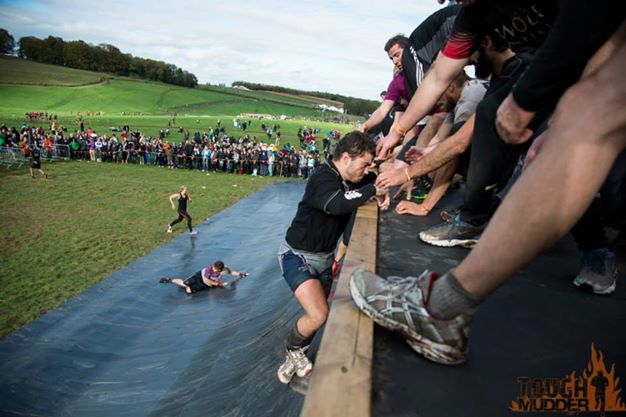Sport and Exercise Medicine: The UK trainee perspective (A BJSM blog series)
By Dr Natasha Beach
Gone are the times when a marathon or triathlon were on the ‘bucket list’ as the “must do” mass participation event. Recent years have seen the rise of military style obstacle assault courses worldwide which present new challenges for the medical teams providing pre-hospital care.
 Tough Mudder is one such event – consisting of a 10-12 mile obstacle course designed to test all-round strength, stamina, teamwork, and mental grit of the “Mudders”. Some of the challenges that Mudders face include scaling high walls, submerging themselves in iced water and dodging live electrical cables in their pursuit to complete these mud based courses. Nearly one million people worldwide took part in this growing event in 2013 and this year saw eight events within the UK and Ireland.
Tough Mudder is one such event – consisting of a 10-12 mile obstacle course designed to test all-round strength, stamina, teamwork, and mental grit of the “Mudders”. Some of the challenges that Mudders face include scaling high walls, submerging themselves in iced water and dodging live electrical cables in their pursuit to complete these mud based courses. Nearly one million people worldwide took part in this growing event in 2013 and this year saw eight events within the UK and Ireland.
One would expect that those choosing to take part in such a demanding event would be at their peak of physical fitness after months of preparation. For the majority this is true, with many having prepared for months or years prior. However, these events have become the target of many charity runners and groups of friends who may have persuaded each other to sign up last minute. This does present potential challenges to the medical teams who may have to deal with those less suitably prepared.
The three functional areas of the medical team
In the most simplistic of terms the medical facilities can be divided into three functional areas: a main medical tent (usually near the finish line), transport, and obstacles. The particular challenge with these courses is anticipating the level of risk that each obstacle poses – this must be considered both in isolation (i.e. the structural design) but also in the context of where within the course each obstacle is placed and what precedes it. For example, climbing a twelve foot wall would be relatively easy if placed early on in the course when competitors are clean and full of energy. However, the risk profile changes dramatically if the wall is placed after a water-based obstacle ten miles into the course when participants are tired and covered in mud.
Vehicle access around the courses poses its own logistical challenge as large areas of the course may be inaccessible to land ambulances. One alternative being utility task vehicles which provides the maneuverability and fast response times required for the difficult terrain, however can only carry seated casualties. This would be insufficient as the only form of transport as some casualties may require transport in a lying position. Off-road ambulances have the advantage of being able to carry patients on a trolley but are comparatively slow and cumbersome. Therefore a combination of both is required around the course to ensure access to all areas with the ability to transport any type of injury.
Prior to the event, those responsible for medical provision need to review the course with the aim of assessing the terrain and therefore the likely response times and vehicles required. Both access to the obstacle and likely injuries must be considered. An obstacle with a high-risk of causing injuries which would require stretcher removal being is placed in an area inaccessible to an off-road ambulance would require to be moved. A close working relationship between event organisers and medical providers is therefore needed for example a joint site visit with the Medical Director, event organiser and course designer in the run-up to the event helps to highlight and rectify any potential issues.
After considering the obstacle type, location, access, distance from the finish medical tent and the climate, the Medical Director can make an assessment of the resources required, taking into account the equipment needed and the skill set and number of personnel, along with their distribution within the three functional areas mentioned.
From experience, these events can result in both medical and trauma based incidents. Therefore those present on site need to have the skills to deal with both – or at least be allocated to an area where their skillset will be best utilised. Unlike many events (such as marathons etc.) where the majority of the workforce are first aiders, with more advanced levels of support present in the minority, obstacle courses such as these require a more even distribution of expertise in order to manage the injury inflow and reduce the impact on local NHS resources where possible.
The popularity of events such as Tough Mudder look set to continue for years to come and with continued investment resources and time in developing comprehensive and detailed response systems we should continue to provide participants with a challenging but safe experience and probably the toughest event on the planet.
************************************
Dr Natasha Beach is an ST5 Sports Medicine Registrar in London and Medical Director for Tough Mudder Ltd.
Dr Farrah Jawad is an ST4 Sports Medicine Registrar in London and coordinates the BJSM TP Blog.